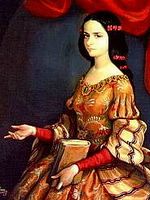We're off to the State Fair!
It can take a trip to the NC State Fair in Raleigh to remind some of us Chapel Hillians that we live in North Carolina
by Mitch Virchick
In a misguided attempt to control traffic jams by evenly spacing the twelve entrances, the fair organizers have seen fit to close one of the two original main gates, and its massive wooden doors solemnly forbid entry. At the open entrance, the ticket window, built for the average North Carolinian when the average North Carolinian?s height was about 4'9", is occupied by an unsmiling middle-aged black woman. One of the perks of seniority in a low-paying state job must be a sweet gig at the state fair.
When I ask if I can have my ticket stub as a souvenir, I am told no, I can?t. No apologies. A middle-aged state trooper sits nearby, unsmiling, sidearm holstered. I decide not to press the issue. Welcome to the grand entrance to the grandest of all fairs, the 153rd annual North Carolina State Fair!
To the left, there's gardening and handicrafts, featuring delicately tatted lace, embroidery, some beautiful, some tacky. Jams, jellies, 4-H displays from Anson or Watauga County.
The state Republican party recruiting booth, featuring good-looking, well-groomed young apparatchiks.
Miracle mops. North Carolina honey. The dowdiest handmade clothing imaginable, including a cocktail dress (I envision the wearer at a country club party in some town like Mocksville, indulging in maybe a shrimp cocktail and a Virgin Mimosa) and lots of crocheted vests, worn by old ladies at Christmas and stout lesbians all year round.
Continuing west along Hillsborough Street, we pass through the perfectly groomed 'field of dreams' in full ripening, likely tended weeks and months in advance of the fair by ag students from 'State College' as the old folks call NC State University in Raleigh. It's good to see tobacco treated respectfully here, not as a noxious weed of death as some would have it, but as a proud historical reminder of North Carolina agriculture and industry. I light a cigarette next to a patch of broadleaf, cough, and nod appreciatively.
A tent draws a small but rapturous multi-racial crowd of heavyset backyard chefs and pig-pickers, all wearing baseball caps, while a video featuring the latest in barbecue technology plays on a monitor and a pig-cooking expert answers tough questions about tenderizing techniques.
Food venders selling dripping sandwich wraps, barbecue, Brunswick Stew, ears of corn and shoelace fries for the Lions, Elks or Shriners charities.
Beyond the food vendors, you catch a view of Dorton Arena, the mid-century futurist elliptical and parabolic cow palace where, during the rest of the year, you can see professional wrestling or badly organized hip-hop events that often enough degenerate into fights. During fair week, the event programmers bring in the country acts, guys with names like Josh, Kenny and Trace.
Past the arena, but further west along Hillsborough Street, we reach the so-called 'meat' of the state fair, the livestock buildings. The biggest one is named after the biggest daddy of agriculture commissioners, Jim Graham, who held sway for something like 70 years over all things farming in North Carolina, and always wore one of those big, LBJ-style white hats. Jim Graham retired just a few years ago, and his replacement, Meg Scott Phipps, from an ancient political family of governors and senators herself, was quickly indicted and charged with egregious campaign finance violations, but I wondered at the time if it was because she had the temerity, as one of her first acts in office, to change midway vendors after 40 years of James E. Strates Shows.
In any case, it?s always best to pass through the livestock shows starting with the worst-smelling, and advancing toward the less offensive. That meant stinking poultry, first up. Beautiful, proud, colorful and entirely foul-smelling, the caged roosters and hens peck about their cages, with the prizewinners going for $6 each.
I have always threatened to build a chicken coop in our yard, two blocks from the middle of downtown Carrboro. When we first moved in 12 years ago, Mr. Neal, the last of the old millhands, kept a henhouse in the woods, out of sight but within earshot. His neighbor Phil would feed the birds, and everybody on the street had fresh eggs until some raccoon or fox got in one night and broke the supply chain. In any case, I have always enjoyed the fact or fancy that livestock still has a role to play in small-town life, and I was sad this past winter when my next-door neighbor Vicki decided to give away her two goats to a farm outside of town.
Still, in the back of my mind, I want to keep chickens, or guinea fowl, or goats, or a mule, or even a pair of draft horses to pull a vegetable cart through the old neighborhoods of my town while shouting at the top of my lungs, at least as a performance art piece.
We as a small-town culture need to be exposed to farm animals, not only because we need to think about the creatures we eat as sentient beings, but on another, less moral or ethical level, as we become more and more distant from our food sources, we become less and less exposed to the germs, the bacteria, and the viral infections these animals carry.
The last stop in the poultry building is the baby duck station, where little children get to pet the adorable little things, and then put their hands in their mouths.
From there, it's on to the Graham Building to see the cattle. Massive, hormonally enhanced, and unable to conceive offspring naturally. ... I resolve next year to study the issues and engage the farmhands in lively economic discourse without fear of getting punched out by a 210 lb. guy in a huge belt buckle.
Because these huge bovines are taking massive, flopping, dumps all the time, the Graham Building, while not smelling nearly as disgusting as the chicken building, still reeks, so I move on to the next building where they keep the goats, and from there, to the pygmy goats. The goats only smell goaty, and it's not so bad, kind of a pleasant aroma. Plus, college chicks seem to dig goats. They wander by the pens in their own herds, with their sorority sisters or boyfriends. Leggy blondes, they find the animals cute. I find them cute. The girls, I mean.
I love to listen to the monotonous rapid-fire chatter of the auctioneer, and I pause and sit in the bleachers. I am wearing work boots and a cowboy hat, and a normal sized belt buckle, but I am at one with the barnyard crowd. A stranger approaches me and asks me where the horses are kept. Beyond, in another corner of the building, some prizewinning vegetables round out this section of the state fair. I marvel at an 856 lb. pumpkin, some perfect peppers, a table full of fat-assed eggplants, and move on. When I retire, I want to be around the fair during the weekdays, when they judge the pies, the pickles, the jellies, the cheeses, the apples, the honey, and the sweet scuppernong wine, and when presumably, there are free samples.
Inexplicably, there is a photographer posing people for $5 (four photos) with life-size cutouts of your favorite president (as long as his name is either Bush, Clinton, or Bush) in an oval-office mockup. I think about posing with W., and pulling a Three Stooges poke-in-the-eye move, or holding up a couple of fingers behind his head, but I imagine there are probably homeland security enforcers lurking about, and I don't want my loyalty questioned, or my family hounded (well, maybe some members of my family), so I reconsider, and move onward.
From here, you have your choice. If you want to move to the next part of the state fair that doesn't involve fried candy bars or nauseating rides, or games of skill and chance at booths burning 20 kilowatts of electrical power, where you can win a stuffed white Siberian Tiger (Siegfried and Roy may be finished as a Las Vegas institution, but their legacy in American kitsch lives on), you have two choices.
The first choice is to slip behind the tightly woven trailers and cut through Carneytown (my choice, naturally). Because tonight I am accompanied by my wife, and because she does not find the midway as appalling as I do (I am, after all, a man of exacting standards of lowbrow taste, intent on catching the horse-shoe pitching competition or listening to the salesman selling miracle mops)...
After this harrowing experience, I must sit down and have a funnel cake. My blood sugar is low. I'm cranky from swimming upstream in the midway, and I need deep-fried southern comfort food. Some fried sweet battered dough, equivalent to about half a dozen glazed donuts, dusted with powdered sugar, should do nicely. I stand in the endless line (actually, I'm behind one person who seems to be having a lot of trouble trying to decide between the elephant ear and the funnel cake and the fried candy bar), rolling my eyes in supercilious, low-blood sugar, apoplectic annoyance. I want to shove this person aside and order my damned funnel cake, but I wait, impatiently sighing, and rolling my eyes, making sure the person in front of me gets the message. He does, and I instantly feel like a jerk. But I'm still hungry, so I forgive myself. Finally, I order my funnel cake, and it arrives, along with a dire warning about how hot it is.
We're back out in the nighttime air, and we wander into the old farm machinery building. Wagons, Tractors, iron-bound wooden wheels that must have broken all the damned time, and plows, and plows, and plows abound inside. A Prairie Schooner is particularly amazing to Ellen. She doesn't believe that families could have existed in such cramped quarters for a drive across country. I remind her we used to take camping vacations with the kids in a Honda Accord, and besides, don't forget, the average North Carolinian was 4 ft. 9 inches back in the day.
I like old forgotten technology. ... I still retain a life-long love of obsolete tools - a 40-pound manual typewriter sits in my workshop, along with an old check-writing machine. My slide rule awaits my recollection of how the damned thing works.
We can visit the horticultural exhibits or we can visit the Village of Yesteryear, a craft show reminiscent of a bygone era when sane and sober people held positions of responsibility, and the gravity of their moral certitude mattered. ... Lots of bonnets, braids, puffy shirts, and leather vests and aprons. Woodcarving. Tinsmithing (possibly my new 'teeny hobby' as my kids would say when they notice me spending way too much effort and money on a passing interest which allowed me to spend more time in the shed away from the family). Basketry. Marquetry. Quilting. Pottery from Seagrove and Jugtown. Some old bearded guy with falconry gloves carrying a cute little screech owl.



 A few of my daughter
Melina's great posts:
A few of my daughter
Melina's great posts:








1 Comments:
I'm so glad you took me to the fair! Now I don't have to go in person.
Post a Comment
<< Home